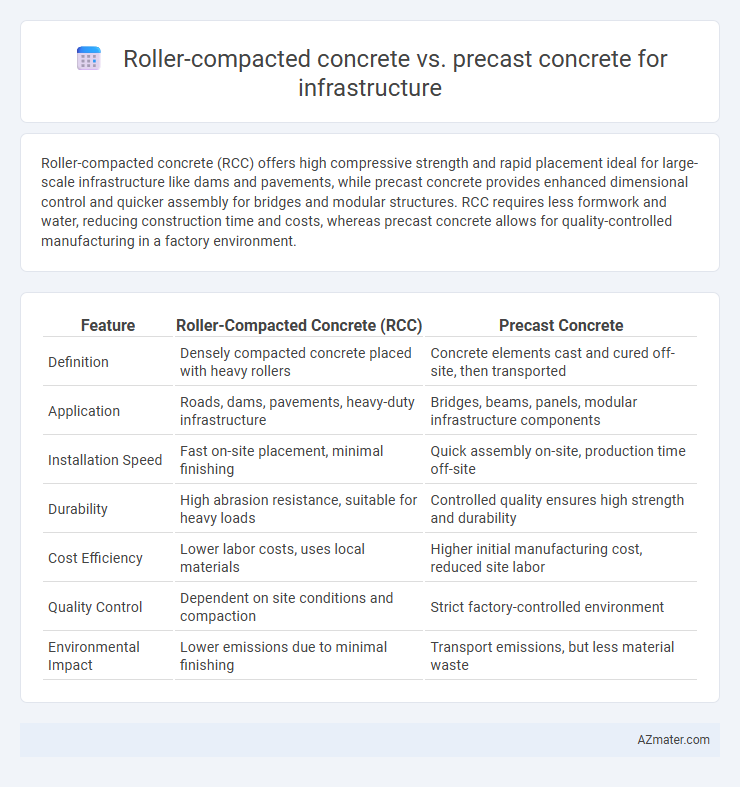Roller-compacted concrete (RCC) offers high compressive strength and rapid placement ideal for large-scale infrastructure like dams and pavements, while precast concrete provides enhanced dimensional control and quicker assembly for bridges and modular structures. RCC requires less formwork and water, reducing construction time and costs, whereas precast concrete allows for quality-controlled manufacturing in a factory environment.
Table of Comparison
| Feature | Roller-Compacted Concrete (RCC) | Precast Concrete |
|---|---|---|
| Definition | Densely compacted concrete placed with heavy rollers | Concrete elements cast and cured off-site, then transported |
| Application | Roads, dams, pavements, heavy-duty infrastructure | Bridges, beams, panels, modular infrastructure components |
| Installation Speed | Fast on-site placement, minimal finishing | Quick assembly on-site, production time off-site |
| Durability | High abrasion resistance, suitable for heavy loads | Controlled quality ensures high strength and durability |
| Cost Efficiency | Lower labor costs, uses local materials | Higher initial manufacturing cost, reduced site labor |
| Quality Control | Dependent on site conditions and compaction | Strict factory-controlled environment |
| Environmental Impact | Lower emissions due to minimal finishing | Transport emissions, but less material waste |
Introduction: Comparing Modern Concrete Solutions
Roller-compacted concrete (RCC) and precast concrete represent advanced materials tailored for infrastructure projects with distinct advantages in durability and construction speed. RCC offers rapid onsite placement suitable for large-scale applications such as dam and pavement construction, leveraging its low water content and compaction methods to achieve high strength and density. Precast concrete, manufactured under controlled factory conditions, ensures superior quality control and versatility in complex structural components, facilitating faster assembly and reducing onsite labor for bridges, tunnels, and buildings.
Key Properties of Roller-Compacted Concrete
Roller-compacted concrete (RCC) features high density, low permeability, and rapid strength gain, making it ideal for heavy-duty infrastructure like dams and pavements. Its minimal water content and stiff consistency enable efficient placement and compaction using heavy machinery, reducing construction time and costs. RCC demonstrates excellent durability, resistance to freeze-thaw cycles, and load-bearing capacity, outperforming many conventional precast concrete elements in long-term performance.
Essential Features of Precast Concrete
Precast concrete offers essential features such as high durability, controlled manufacturing conditions, and uniform quality, making it ideal for infrastructure projects requiring precision and rapid installation. Its modular nature allows for faster construction timelines and reduced on-site labor compared to roller-compacted concrete. Additionally, precast concrete components provide excellent load-bearing capacity and resistance to environmental stress, enhancing long-term infrastructure performance.
Construction Methods: On-site vs Off-site Production
Roller-compacted concrete (RCC) is primarily produced on-site using heavy rollers to compact the concrete mixture rapidly, enabling faster construction of large infrastructure projects such as dams and pavements. Precast concrete, however, is manufactured off-site in controlled factory environments, allowing for higher quality control and precision, then transported to the construction site for assembly. The on-site production of RCC reduces transportation costs and time, while off-site precast concrete enables modular construction and minimizes on-site labor.
Strength and Durability Considerations
Roller-compacted concrete (RCC) offers high compressive strength and excellent durability due to its low water-cement ratio and dense aggregate matrix, making it ideal for heavy-duty infrastructure like dams and pavements. Precast concrete provides consistent quality and controlled curing conditions, resulting in superior tensile strength and enhanced resistance to environmental stresses, which benefits bridges and structural components. Both materials exhibit excellent durability, but RCC excels in mass concrete applications while precast concrete is preferred for modular construction requiring precise strength and durability.
Speed of Installation and Project Timelines
Roller-compacted concrete (RCC) offers faster installation due to its continuous paving process and rapid curing, significantly reducing project timelines compared to precast concrete, which requires factory manufacturing, transportation, and on-site assembly. RCC's ability to be placed with conventional earthmoving equipment accelerates large-scale infrastructure projects like dams and pavements. Precast concrete, while providing high quality and controlled conditions, often introduces delays related to logistics and crane operations during installation.
Cost Comparison: Materials, Labor, and Maintenance
Roller-compacted concrete (RCC) typically offers lower initial material costs due to its use of a drier mix with less cement and aggregates compared to precast concrete, which requires precise casting molds and high-quality materials. Labor expenses for RCC are generally reduced because it can be placed quickly with heavy machinery on-site, whereas precast concrete demands skilled labor for fabrication, transportation, and installation. Maintenance costs tend to be lower for RCC infrastructure due to its monolithic construction, minimizing joints and potential weak points, while precast components may require more frequent inspections and repairs at connection seams.
Sustainability and Environmental Impact
Roller-compacted concrete (RCC) offers significant sustainability advantages for infrastructure by reducing cement content and water usage, leading to lower carbon emissions compared to traditional precast concrete. Precast concrete manufacturing often involves energy-intensive processes and transportation emissions, whereas RCC is placed directly on-site, minimizing environmental impact and material waste. Both methods contribute to durable infrastructure, but RCC's efficient resource utilization and decreased carbon footprint position it as a more environmentally friendly option for sustainable construction projects.
Typical Applications in Infrastructure Projects
Roller-compacted concrete (RCC) is commonly used in infrastructure projects such as dam construction, road pavements, and airport runways due to its high strength, low permeability, and rapid placement capabilities. Precast concrete is typically employed for bridges, tunnels, retaining walls, and utility vaults, offering benefits like quality control, faster installation, and reduced site disruption. Both materials enhance durability and structural integrity, with RCC favored for massive, monolithic applications and precast concrete preferred for modular, repetitive components.
Choosing the Right Concrete: Decision Factors
Selecting between roller-compacted concrete (RCC) and precast concrete for infrastructure projects depends on factors such as project timeline, load-bearing requirements, and site conditions. RCC offers rapid on-site placement and high durability for pavements and dams, while precast concrete provides controlled factory conditions ensuring consistent quality for structural elements like bridges and tunnels. Evaluating cost efficiency, installation speed, and long-term maintenance needs guides optimal concrete choice for specific infrastructure demands.

Infographic: Roller-compacted concrete vs Precast concrete for Infrastructure
 azmater.com
azmater.com